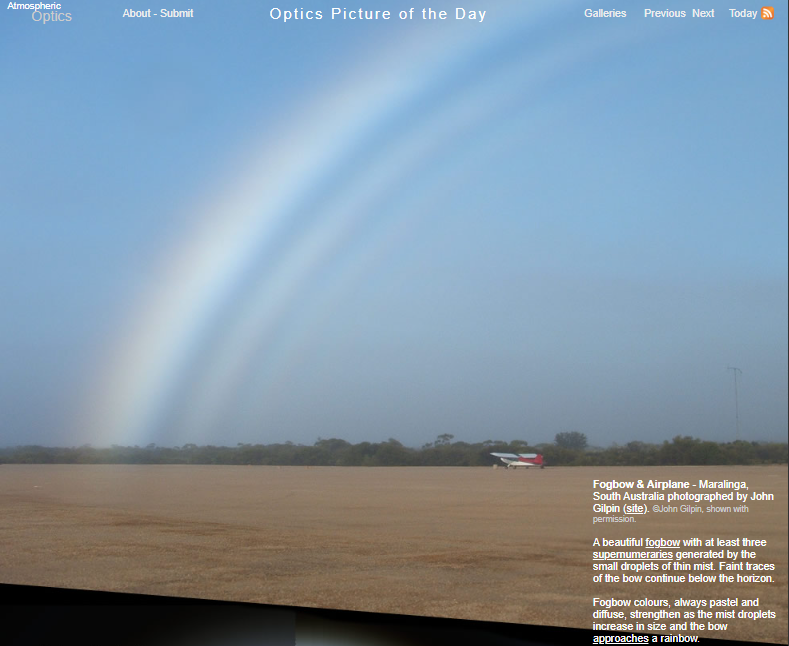Fogbow - Australia
Fogbow - Australia: Exploring the Ethereal Beauty
Fogbows, also known as white rainbows or ghost rainbows, are captivating atmospheric optical phenomena that occur when sunlight interacts with small water droplets suspended in fog or mist. While they share similarities with rainbows, fogbows possess their own unique characteristics that make them a mesmerizing sight to behold. In this article, we will delve deeper into the enchanting world of fogbows, with a particular focus on their occurrence in Australia.
The Enigmatic Beauty of Fogbows
Fogbows are characterized by their ethereal and pastel colors, which give them a delicate and diffuse appearance. Unlike rainbows, which feature a full spectrum of colors, fogbows tend to display only pale shades. However, as the size of the water droplets increases and the fogbow approaches a rainbow, its colors intensify and become more vibrant.
Supernumeraries: An Extraordinary Sight
One of the most captivating aspects of fogbows is the presence of supernumerary arcs. These additional, fainter arcs appear on the inside of the main primary bow and exhibit more saturated colors than the primary bow itself. As these supernumeraries converge towards the glory at the antisolar point, their hues deepen, creating a stunning visual effect. Interestingly, the order of colors in supernumeraries is reversed compared to the primary bow, with red hues appearing on the inside.
Fogbow Sightings in Australia
Australia, with its diverse landscapes and atmospheric conditions, offers a prime setting for witnessing the enchanting beauty of fogbows. One notable sighting took place in Maralinga, South Australia, where photographer John Gilpin captured a breathtaking image of a fogbow alongside an airplane. The image showcases at least three supernumeraries generated by the small droplets of thin mist, with faint traces of the bow extending below the horizon.
The Science Behind Fogbows
The formation of fogbows is closely linked to the principles of light refraction, diffraction, and reflection. When sunlight encounters water droplets in the air, it undergoes refraction as it passes through the droplets, causing the light to bend. As a result, the light is dispersed into its component colors, creating a circular arc of colors. In the case of fogbows, the water droplets are relatively small, leading to diffraction effects that result in the pale and diffuse appearance of these optical phenomena.
The Role of Droplet Size
The size of the water droplets suspended in the fog or mist plays a crucial role in determining the characteristics of fogbows. Smaller droplets produce fainter and less saturated colors, while larger droplets result in more intense and vibrant hues. This explains why fogbows tend to become more rainbow-like as the droplets increase in size.
Simulating Fogbows
Scientists employ Lorenz-Mie simulations to better understand and simulate the formation of fogbows. These simulations use mathematical models to recreate the interaction between light and water droplets of varying sizes. By studying these simulations, researchers can gain insights into the intricate details of fogbow formation and explore how different factors, such as droplet size and atmospheric conditions, influence their appearance.
Embracing the Mystical Atmosphere
Fogbows have a mystical and otherworldly quality that captivates our imagination. Their presence amidst a backdrop of fog or mist creates an ambiance of serenity and wonder. Whether you encounter a fogbow in Australia or any other part of the world, take a moment to appreciate the delicate beauty that nature has bestowed upon us.
In conclusion, fogbows are an awe-inspiring atmospheric optical phenomenon that adds a touch of enchantment to our surroundings. With their pastel colors, supernumerary arcs, and delicate appearance, fogbows offer a mesmerizing sight for those fortunate enough to witness them. Australia, with its diverse landscapes and atmospheric conditions, provides an ideal setting for experiencing the ethereal beauty of fogbows. So, keep your eyes peeled and embrace the mystical atmosphere when fog descends upon the land, as you may just catch a glimpse of a captivating fogbow dancing in the mist.

Fogbow & Airplane - Maralinga, South Australia photographed by John Gilpin (site). ©John Gilpin, shown with permission.
A beautiful fogbow with at least three supernumeraries generated by the small droplets of thin mist. Faint traces of the bow continue below the horizon.
Fogbow colours, always pastel and diffuse, strengthen as the mist droplets increase in size and the bow approaches a rainbow.
A fogbow's supernumerary arcs have more saturated colours than the main primary bow and they deepen as the supernumeraries converge towards the glory at the antisolar point.
Supernumerary colours are also reversed - red hues on the inside.
Lorenz-Mie simulations by IRIS.

Note: this article has been automatically converted from the old site and may not appear as intended. You can find the original article here.
Reference Atmospheric Optics
If you use any of the definitions, information, or data presented on Atmospheric Optics, please copy the link or reference below to properly credit us as the reference source. Thank you!
-
<a href="https://atoptics.co.uk/blog/fogbow-australia/">Fogbow - Australia</a>
-
"Fogbow - Australia". Atmospheric Optics. Accessed on November 26, 2024. https://atoptics.co.uk/blog/fogbow-australia/.
-
"Fogbow - Australia". Atmospheric Optics, https://atoptics.co.uk/blog/fogbow-australia/. Accessed 26 November, 2024
-
Fogbow - Australia. Atmospheric Optics. Retrieved from https://atoptics.co.uk/blog/fogbow-australia/.